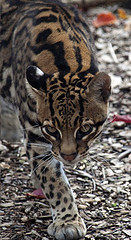Ocelot
 Ocelot: Felis pardalis.
Ocelot: Felis pardalis.
Distribution: From Argentina to Arizona
Habitat: Forest and scrubland.
Size: Body Length: 65-69cm Tail Length: 27-40cm Weight: 11-16kg
Lifespan: 17 years in captivity.
Food: Agoutis, hares, mice, monkeys and birds.
Sexual Maturity: 6-8 months
Mating: Once or twice a year.
Gestation: 70 days.
Litter size: 2-4 kittens
Territory: Ocelots live in forests and scrubland. They are extremely well camouflaged. In a forest habitat the coat is golden in colour, whereas in scrubland, it has a greyish tinge to its fur. Ocelots spend time resting in trees, and climb down them backwards. Most are solitary, and mark their territory by spraying trees with urine. Pairs, however, are not unknown.
Daily life: The ocelot relies on its hearing and eyesight to detect prey when hunting at night. Prey animals include agoutis, hares, monkeys, birds and mice, but an ocelot will eat anything it can kill. All hunting is done on the ground, with the ocelot stalking its prey until it gets very close, then pouncing and catching it with its sharp claws. A quick bite to the neck is then enough to kill the victim. Small prey is eaten head-first, but if the prey is too big, the ocelot will start with a soft part of the body.
Breeding: Ocelots may breed up to twice a year, in summer and winter. Females call loudly to attract a male when they are in season. During mating, the male grasps the female by the back of the neck until after mating is complete. After mating the female attacks the male, but then invites him to mate again.
Pregnancy lasts just over two months, and the two to four young are born in a hidden nest. Kittens are fully furred, but blind and helpless at birth. They feed only on their mother's milk for the first two weeks, and she eats their droppings to keep the nest clean. As they get older, the mother brings them live prey to teach them how to kill. When they become competent hunters, they will either leave the mother of their own accord, or be driven away by her.
Ocelots have been hunted extensively for their pelts but they are now fully protected from hunting under international law.
Read More: Jaguar